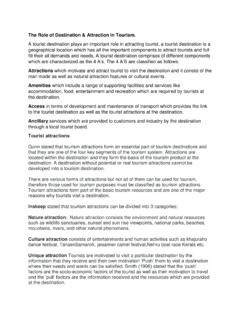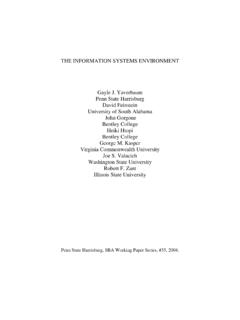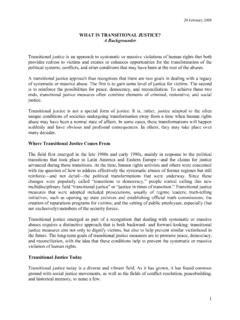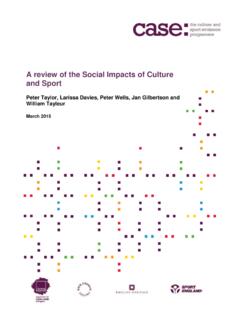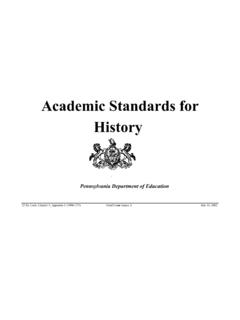Transcription of The Small Museums Cataloguing Manual - AMaGA Vic
1 The Small Museums Cataloguing Manual A guide to Cataloguing object and image collections The Small Museums Cataloguing Manual A guide to Cataloguing object and image collections 4th EDITION. Museums australia victoria Published by Museums Australia (Victoria), 2009. Text Museums Australia (Victoria), 2009. Images as indicated Museums Australia (Victoria). Melbourne Museum Carlton Gardens, Carlton PO Box 385. Carlton South, Victoria 3053. (03) 8341 7344. Regional freecall 1800 680 082. First published 1983. 2nd edition c. 1990. 3rd edition 1996. 4th edition 2009. ISBN: 978 0 9806707 0 7. Editors: Hilary Ericksen and Ingrid Unger Designer: Janet Boschen Cover images: Ben Healley (ferret box, postcard, album, coffee cup and carpet bowls). Michelle McFarlane (Magpie eggs). Predrag Cancar (pram carriage).
2 John Broom eld (keyboard). Museums australia victoria Contents Acknowledgements 5. Introduction 7. Why Catalogue Collections 11. Enriching cultural value 12. Enhancing administration 14. Essentials 17. Policy documents 18. Introducing worksheets 19. Cataloguing tools 20. Handling objects 23. Managing digital les 26. The Register 29. Registering objects 30. Numbering objects 35. The Catalogue 43. Cataloguing objects 45. Appendices 65. 1. Cataloguing worksheet 66. 2. Sample Cataloguing worksheets 68. 3. Glossary of descriptive terms 78. 4. Glossary of production methods 81. 5. Glossary of materials 85. 6. Useful resources 94. Margaret Fullwood, Evelyn Wright and Val Lawrence look over Captain John Hepburn's ag, Creswick Museum. Photograph: Julie Millowick. Source: Department of Planning and Community Development 4.
3 Acknowledgements This fourth edition of The Small Museums Cataloguing Manual would not be possible without the generous funding support of Heritage Victoria and Arts Victoria. We're grateful for their commitment to caring for the state's heritage collections. Museum Victoria and the Department of Planning and Community Development have kindly supplied the photographic material. The Manual is based on work undertaken for previous editions. For this edition we would like to acknowledge the contributions of Caroline Carter, Euan McGillivray, Janet Path and Roger Trudgeon. 5. Trophies and team photographs from Huntley Football Club, Huntley and District Historical Society. Photograph: Julie Millowick. Source: Department of Planning and Community Development 6. Introduction This publication is the fourth edition of The Small Museums Cataloguing Manual , a guide to the hands-on process of documenting objects and visual material in heritage collections.
4 Its genesis stretches back more than two decades to work undertaken by Arts Victoria. Trench art at Bendigo RSL Soldiers Memorial Museum. Photograph: Julie Millowick Source: Department of Planning and Community Development 7. I N T R O D UCT I O N. In 1983, Arts Victoria's Museum Resource Service developed a standardised Cataloguing system for regional and community Museums , initiated to help educate Small -museum staff and volunteers about the importance of documenting collections. The objective was to develop a standardised methodology that was exible enough to recognise that no two collections are ever the same. They are of differing content and specialisation; objects are of differing size, material and shape;. and Museums access and use their collections in different ways, with different resources available to them.
5 The need for standardising Cataloguing procedures and techniques was also recognised. This would re ect the national standard of an effective system for recording and retrieving information about collection items. It would also enable computerisation of the catalogue, as the technology became the norm in Small Museums . The Small Museums Cataloguing Manual stems from this desire for a set of common practices, and it has been used in training staff and volunteers and for reference ever since. Some 25 years on from the rst edition, The Small Museums Cataloguing Manual continues to provide industry-standard knowledge of this important documentation process. Due to object acquisition and movement, and to address the inevitable backlog of undocumented collection items, Cataloguing is an ongoing process in any museum.
6 Today, computers are an indispensible tool for such work, and are commonplace even in Small Museums focused on local heritage or devoted to specialist material. Although Cataloguing has become computerised rather than paper-based, Museums Australia (Victoria). still urges community Museums to use paper worksheets as a step in Cataloguing their collections on computer. The bene ts include reasonably fast documentation and quality object records. The most fundamental reorientation of this revised edition of the Manual is its assumption that community and regional Museums , as well as individual collectors, will build or will already have built their catalogue electronically that is, on a computer. This reorientation has meant some changes in information from previous editions, and some omissions.
7 For example, an electronic catalogue renders the card index obsolete, as database searches quickly call up all relevant records. Consequently, we've omitted information relating to card indexes. 8. I N T R O D UCT I O N. Similarly, the Manual no longer includes a chapter on Cataloguing archives. This is not so much because of computerisation, but because the Public Records Of ce Victoria has developed a Places of Deposit (POD) program, which makes it unlikely that community Museums will acquire archives. At the time of writing more than 120 facilities across Victoria were operating as PODs. These provide a network of sites that meet standards for the safekeeping of document archives. A full list of PODs can be found at The National Archives of Australia also publishes a very useful guide to archives, titled Keep it for the future!
8 How to set up Small community archives, which we recommend to organisations acquiring an archive. As the Manual 's name suggests, it focuses on Cataloguing rather than on collection preservation, storage and handling, which were covered to some extent in previous editions. However, attention is necessarily given to the context and activities related to Cataloguing . So in the rst three chapters we discuss the rationale for Cataloguing , relevant policy documents, the tools required for Cataloguing , managing digital les, handling objects during Cataloguing and object registration and numbering. Previous editions of the Manual included two worksheets, for photographic and non-photographic material. This edition has a single worksheet that can be used for all collection items. The concept of the worksheet is introduced in Essentials', while the core chapter, The Catalogue', works through each eld in a catalogue record, discussing the information required and its purpose, and providing several examples.
9 As well as containing blank and sample worksheets and a list of useful resources, the appendices include three glossaries to help cataloguers document collection items; they cover materials, production methods and descriptive terms. The glossaries are intended to help cataloguers create meaningful catalogue records for each object by using standard terminology, which will aid any future centralisation of the catalogue. Museums Australia (Victoria) hopes that this revised edition of The Small Museums Cataloguing Manual will serve its members well in enhancing the cultural value and administration of their heritage collections. 9. Elwyn Blood displays a day dress worn by Eliza Perrin around 1860, Ballarat Gold Museum. Photograph: Julie Millowick. Source: Department of Planning and Community Development 10.
10 Why Catalogue Collections Documenting the collection is vital to a museum's active and responsible role in managing its key asset, no matter what the focus of the collection. The reasons for Cataloguing are many and varied, but they roughly fall under enriching the collection's cultural value and enhancing its administration. Child's carriage-style pram for two infants, c. 1900. Photograph: Predrag Cancar. Source: Museum Victoria 11. W HY CATALO GUE C O LLE CT I O N S. Enriching cultural value Cataloguing underpins many important museum activities, including research, exhibition development, conservation, risk management, publication and outreach work, all of which are dependent on detailed and up-to-date collection information. Documenting an object enriches its intrinsic value. The accumulation of information gives an object meaning and context, and results in a stronger understanding of its uniqueness, its contribution to the collection and its reason for being collected in the rst place.
